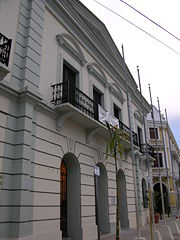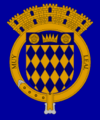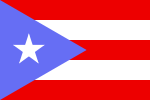Arecibo, Puerto Rico
| Arecibo, Puerto Rico | |||
|
|||
| Nickname(s): La Villa del Capitán Correa", "Muy Leal", "Ciudad del Cetí", "Diamante del Norte" (the north diamond), "La Ribera del Arecibo" (the shore of the Arecibo) | |||
 |
|||
| Country | United States | ||
|---|---|---|---|
| Territory | Puerto Rico | ||
| Founded | 1616 | ||
| Government | |||
| - Mayor | Lemuel Soto (PNP) | ||
| - Senatorial dist. | 3 - Arecibo | ||
| - Representative dist. | 13, 14 | ||
| Area | |||
| - Total | 171.2 sq mi (443.46 km²) | ||
| - Land | 126 sq mi (326.31 km²) | ||
| - Water | 45.2 sq mi (117.15 km²) | ||
| Population (2000) | |||
| - Total | 100,131 | ||
| - Density | 794.9/sq mi (306.9/km²) | ||
| - Gentilic | Arecibeños | ||
| Time zone | AST (UTC-4) | ||
| Anthem – "Arecibo" | |||
Arecibo (ah-re-SEE-boh) is a municipality in the northern midwest coast of Puerto Rico and located by the Atlantic Ocean, north of Utuado and Ciales; east of Hatillo; and west of Barceloneta, and Florida. Arecibo is spread over 18 wards and Arecibo Pueblo (The downtown area and the administrative center of the city). Arecibo is located on the north coast of the island of Puerto Rico, about 80 kilometres (50 miles) west of San Juan, or approximately a 1-hour trip by car. It is the largest city in area in Puerto Rico and is part of the San Juan-Caguas-Guaynabo Metropolitan Statistical Area.
Arecibo is known as El Diamante Del Norte (North's Diamond) as well as La Ribera del Arecibo (The shore of Arecibo). Arecibo is also known as La Villa del Capitán Correa (Captain Correa's Villa) after the Puerto Rican hero Captain Antonio de los Reyes Correa, who as a member of the Spanish Army defended Arecibo from a British invasion led by Admiral Whelstone in August 5, 1702. The nearby Arecibo Observatory is known for housing the world's largest radio telescope. Arecibo is the head of the Roman Catholic Diocese of Arecibo.
Contents |
History
Arecibo, settled in 1556, was the island's third Spanish settlement, after Caparra (which later became San Juan), and San German. It is named after the Taíno Cacique Xamaica Arasibo, who ruled the Taino yucayeke (town), then named Abacoa. Arecibo was officially founded as a city by the Spanish crown May 1, 1616, under the governorship of Captain Felipe de Beaumont y Navarra, when the King of Spain granted the land (and the Tainos living there) to Lope Conchillos.
Flag
The flag of Arecibo derives its composition and colors from the Shield of the City. It is divided vertically in two equal parts. The left side is blue having a belt that stands for "Captain Correa", a local military hero from Spanish times. The right side is made up of blue and yellow diamonds alternating in a checkerboard pattern.
Coat of Arms
The shield is divided by diagonal lines in golden and blue rhombuses with a blue stripe in the superior part, in which resides an opened five-point crown and which is adorned with drawings characterizing the art of the Taínos. This combination of symbols represents the Indian Cacique (Chieftain) from whom the population's name derives, the governor that erected the town and the hero Captain Correa who defended it.
Barrios (Districts/Wards)[1]
|
|
|
Geo/Topography
- Cambalache Forest Reserve
- Dos Bocas Lake
- Río Abajo Forest Reserve
- La Cueva del Indio
Anthem
By José A. Monrouzeau
Villa y ciudad te conocí
acariciada por el mar
prodigio es ver cerca de tí
ríos formandose un collar
porque eres tú cuna gentil
de nuestro gran Pachín Marín,
Víctor Rojas también
de Campeche un jardín,
del Capitán Correa, el invicto,
fue un edén.
Arecibo, Arecibo
yo nunca te podré olvidar,
pueblecito de mis amores
que como tú no hay otro igual.
Por tus atletas y tus héroes
tus hijos te saben querer,
con sus mujeres en sus quereres
gratos recuerdos del ayer.
En el baseball estrellas son
Rodríguez Olmo con Pellot.
En basketball gran sensación
con John Padilla en Nueva York.
Así también cual campeón
Petaca Iguina es colossal.
Nuestros atletas son bravos
por su ideal por eso
gozan de fama y admiración.
Arecibo, Arecibo
yo nunca te podré olvidar,
pueblecito de mis amores
que como tú no hay otro igual.
Por tus atletas y tus héroes
tus hijos te saben querer,
con sus mujeres en sus quereres
gratos recuerdos del ayer.
Business
Arecibo's main shopping malls are Plaza del Norte, located in the neighboring town of Hatillo, and Plaza del Atlantico.
Industrial
Arecibo is home to Fortune 500 corporations such as Merck, General Electric, and Pfizer. Another important company is Thermo King Corporation.
Radio Stations
- WCMN-FM - Toca De To' 107.3 FM
- WCMN-AM - NotiUno 1280 AM
- WNIK-FM - Super K 106 FM
- WNIK-AM - Radio Unica
- WMIA-AM - MIA
Tourism
Landmarks and places of interest
- Cathedral of Saint Phillip Apostle

Arecibo is one of the oldest towns in Puerto Rico (1616) and as result has some antique structures. One of which is the Cathedral of Saint Phillip Apostle. The original church was built towards the middle of the 17th century and was destroyed by an earthquake in 1787, construction of a new one began soon after, although it was not completed until 1846. Four days after its dedication another quake seriously damaged it, and still in 1875 necessitated repairs were not completed until 1882. The 1918 earthquake damaged the vault so badly it was replaced by a flat concrete roof; a vaulted ceiling of composition board was placed inside.
The cathedral of Arecibo is Puerto Rico's second largest church after the Cathedral of San Juan. The plan is rectangular with three naves; the side naves are cut short to allow large flanking chapels which occupy almost half the length of the church. The apse is semicircular, and has an unusual half-dome covering it. The facade is a triangular composition of three stages, although the top stage, a short central tower, is a later addition, according to local architects and historians. Neoclassic ornamentation is used in an academic fashion on the lowest stage, but the other two show a less traditional use of bands and pilasters. The Renaissance style windows are uncommon in Puerto Rican churches, but the central tower over the entrance is frequently seen throughout the island.
- City Hall

The City Hall built in 1866, served as jail to "El Grito de Lares" participants in 1868. In 1918, the frontal section of the building was destroyed by an earth tremor. Repairs were made and a tower and clock were added to the building. In 1978, the building was restored to its original form. The City Hall of Arecibo is typical of these regional seats of government. It is relatively modest in size, of stuccoed masonry, with an academically correct composition having a pedimented center pavilion which projects slightly. The lower story is rusticated, with arched openings, the three doorways in the center giving the effect of a loggia. The upper windows all have segmental pediments and balconies; the central trio shares one long balcony. Architectural detailing is modest but the building is graceful and charming.
- Punta Los Morrillos Lighthouse
In 1898 the Spaniards built the Arecibo Lighthouse which was automated in 1964 and is in use today. Today, there is a small park called Arecibo Lighthouse and Historical Park that surrounds the lighthouse.
The Arecibo Observatory is the largest single-unit radio telescope ever constructed and one of the world's most powerful radar-radio telescope. While the observatory exists to support scientific studies, a number of Hollywood movies have been filmed there, most recently GoldenEye and Contact. The radio telescope was used in 1974 to send the Arecibo message to space.
- Cambalache Forest Reserve

Forest between Arecibo and Barceloneta.
- Casa Ulanga
Originally a residence built by Spanish immigrant Francisco Ulanga, it was later used as a bank, store, city hall of Arecibo, hospital, jail, tribunal, and now the Arecibo Cultural Center.
- Cueva del Indio Cavern
Archeological site where Taíno drawings can be found
- Dos Bocas Lake
Reservoir between Arecibo and Utuado.
- Paseo Victor Rojas(Victor Rojas' Walk)
Also known as Paseo de Damas or simply El Fuerte, it was built in 1881 where Fort San Miguel's ruins once were.
- Manuel "Petaca" Iguina Coliseum
Home of the Arecibo Captains basketball team.
- Beaches
Nearby beaches include Los Morillos Beach, Los Negritos Beach, Poza del Obispo Beach, Las Tunas Beach.
- Museum of Art and History of Arecibo
Shows art from local artists and shows the city's history.
Also nearby () is a facility for launching sounding rockets. Since 1966 many rockets of the Nike Apache, Nike Javelin, Nike Iroquois, Nike Tomahawk, Black Brant, Taurus Orion, and Terrier Orion types have been launched from this facility.
Festivals and events
- Bicycle Competitions - January
- Arecibo Carnival - February
- Patron Festivities San Felipe Apóstol - May
- Playero Festival - July
- Folklore Festival - July
- Craftsman Fair - September
- Ceti Festival - November
- Puerto Rico's Flag Centennial - December
Transportation
- Airport
Arecibo has a small noncommercial airport, named Antonio (Nery) Juarbe Pol Airport, which has not had airline flights in about two decades.
- Roads
PR-22 (unsigned Interstate PR-2) passes through the city, but bypasses downtown. Downtown can be accessed via PR-2, PR-10 and PR-129.
Sports
Arecibo has two professional sports franchises, the Lobos de Arecibo in baseball and the Capitanes de Arecibo in BSN basketball. The Lobos won the 1983 national baseball championship and the 1983 Caribbean World Series, the only time the franchise won both titles. At that time, they had MLB prospect Dickie Thon, then also of the Houston Astros, on their roster. Thon then suffered a life-threatening and career-affecting eye injury during an Astros game in 1984. The Lobos won a championship again in 1996.
The Capitanes won their first ever champioship in 1959. After that, the Capitanes have not had much luck in their basketball tournaments, but in 2002, they started to turn things around, reaching the semifinals. However, they lost the series to the Vaqueros by losing 4 straight games, after having a 3-0 game lead in the series. The Capitanes won the National Superior Basketball championship on 2005 beating the Vaqueros of Bayamón in 4 games. This was the first championship in 46 years. In 2007 they got to the finals, losing in the overtime on the seventh game of the series against Los Cangrejos de Santurce. In 2008 Arecibo won the tournament championship again against the Gigantes of Carolina.
Famous "Arecibeños"
- Alexis Adorno Nuñez - Military hero (US Air Force)
- Antonio de los Reyes Correa - Military hero
- Arasibo - Taino Cacique
- Cayetano Coll y Toste, physician/historian
- Francisco Gonzalo Marin (1897-1963) - poet/politician
- Luisa Capetillo - Labor leader
- Manuel Zeno Gandía (1855-1930) Doctor, journalist & politician
- Maria Cadilla de Martinez, Professor/writer
- Myrta Silva, singer/songwriter; former lead vocalist for Sonora Matancera
- René Marqués, Dramatist
- Candy Maldonado, MLB Baseball Player
- Warren A. James - Architect
References
External links
- Arecibo and its barrios, United States Census Bureau
- Welcome to Puerto Rico Arecibo
- Arecibo Observatory Home
|


